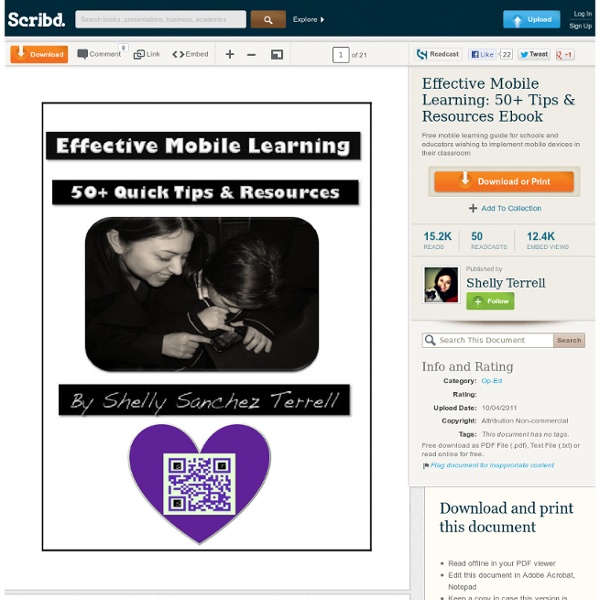



Pine Glen Library & Technology Center » Setting up a cartful or two of iPads Pine Glen was very fortunate to receive 60 iPads this school year on two Bretford Power Sync Carts! The Carts will make management of the iPads easier, because they provide a central place to store, recharge, and sync the iPads to the iTunes library on my laptop. It was quite a bit of work to get the iPads ready to go for the students. I made a few mistakes a long the way, but here’s the most efficient method that I’ve found for getting all the iPads up and running in a uniform manner, particularly if you already have a bunch of free apps and apps purchased from the Volume Purchase Program: 1. Unbox all the iPads and place them in the cart. 2. 3. 4. 5. 6. 7. 8. 9. 10. 11. a. b. c. 12.
Issuu - You Publish www.ericsson.com/ericsson/corpinfo/programs/incorporating_mobile_learning_into_mainstream_education/products/book/introduction.pdf Amazon.com Help: Kindle Keyboard Software Update ipad | Search Results | Terice T. Schneider's Digital Home Starting School with New iPads, Chromebooks, or Tablets? School starts soon for so many, and it’s time to support all of you with new devices in your classrooms. Now what? 3 Questions to Answer as You Plan for End-of-the-Year Return of iPads As the end of the school year looms closer, thoughts turn to how you will take up the iPads or whatever device you may use. 3 Big Myths: iPads in the Classroom As Vicki Ventura and I have visited teachers and administrators from multiple districts throughout the last several months, we are consistently surprised that these beliefs about iPads in the classroom still exist. How Do You Change Instruction? What is the purpose of having iPads in the classroom? 10 Reasons Not To Go 1:1 iPads Yes. Five Things to do NOW if You Are Deploying iPads in the Fall August 1 is here, and in Texas that means school starts this month. What I Wish I'd Done Before Deploying iPads to 735 Middle Schoolers, Part 2 We planned. 5 Tips to Prepare Teachers for 1:1 iPad Projects
The New Library: Ebook Checkouts Up 200% With the rise of digital books on the Kindle and the iPad, how is your local paper-based library keeping up? By fighting fire with fire. Ebook checkouts increased by more than 200% in 2010, according to a recent study from OverDrive, the leading distributor of ebooks and digital audiobooks to libraries. Ebook checkouts continue to accelerate, almost tripling through September. This adds to the more than 12 million ebook checkouts so far in 2011, paidContent reports. More than two-thirds of public libraries in the U.S. now offer ebook checkouts, more than 15,000 of which use OverDrive's platform. While patrons will always have use for hard copies of books and manuscripts, ebooks can reach far more people while appealing to a younger demographic of new library patrons. Ebook checkouts may be cannibalizing hard copy checkouts — but if that means more people are reading books, the library is doing its job. Would you rent an ebook instead of purchasing it?
Teaching with Apps Can a $35 Tablet Be as Effective a Learning Tool as an iPad? Digital Tools Ubislate When Amazon unveiled its new Android tablet, the Kindle Fire last month, analysts said that its price could well make it a viable competitor to the wildly successful iPad. Two new tablet alternatives were announced last week that make those prices seem absolutely exorbitant. “The intent is to start a price war. The I-slate will be an electronic version of the hand-held blackboard slates used by many school children around the world. Promises of these sorts of low-costs devices — under development or in production — have been ongoing for a while now. The Aakash tablet was developed and manufactured by a British company called DataWind in partnership with the Indian government. Despite that low price-tag, the device is actually fairly powerful. Clearly this is no iPad. With access to the Internet, e-books, and learning apps, it will be interesting to watch how devices like the Fire and the iPad will fare in the price wars against these kinds of low-cost tablets.